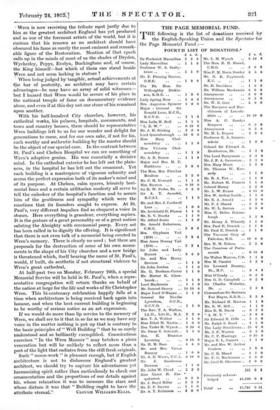OUR GREATEST ARCHITECT.
CENTENARY celebrations of the births and deaths of the illustrious produce in some of us a contra- dictions reaction disposing us to critical questioning rather than to adulation. It is more original, and usually more entertaining, to take a perverse line, and to suggest doubts and reservations rather than to join the majority when they " Praise Famous Men."
To Sir Christopher Wren, however, we cannot do less than offer a whole-hearted and generous homage on the bi-centenary of his death, the homage due to a great man who was great not only in. his chosen art and who was not merely illustrious through a fortunate set of chances.
The present celebrations have called forth an almost bewildering number of special articles on Wren in this or that .capacity and from this or that point of view, and in all of thein we find depicted a vivid and penetrating in: telligenee, a leaping imagination combined with a vigorous sanity, unblemished integrity, kindliness and prodigious assiduity. We are given pictures of him as a mathema- tician, the friend of Newton and Fellow of All Souls, as Savilian Professor of Astronomy, as an engineer, as a writer and a dialectician—even as a Member of Parlia- ment—and it is always the portrait of a commanding, attractive personality. ' Wren is now receiving the tribute most justly due to him as the greatest architect England -has yet produced and "as One of the foremost artists of the world, but it is curious that his renown as an architect should have obscured his fame as surely the most eminent and remark- able figure of the Restoration. Mention of that epoch calls up in the minds of most of us the shades of Dryden, Wycherley, Pepys; Evelyn, Buckingham and, of course, the King himself—but which of them can stand beside Wren and not seem lacking in stature ?
When being judged by tangible, actual achievements at the bar of posterity, an architect may have certain advantages—he may have an array of solid witnesses— but I hazard that Wren would be secure of his place in the national temple of fame on documentary evidence alone, and even if at this day not one stone of his remained upon another.
With his half-hundred City churches, however, his cathedral works, his palaces, hospitals, monuments, and town and country houses, there should be representative Wren buildings left to us for our wonder and delight for generations to come, and for our own sake, if not for his, each worthy and authentic building by the master should be the object of our special care. In the contrast between St. Paul's and Chelsea Hospital we can see something of Wren's adaptive genius. His was essentially a decisive mind. In the cathedral exterior he has left out the plain- ness, in the hospital he has left out the ornament. Yet each building is a masterpiece of vigorous urbanity and seems the perfect expression both of its maker's mind and of its purpose. At Chelsea, calm spaces, leisurely hori- zontal lines and a certain utilitarian modesty all serve to tell the onlooker of the hospital's function and to assure him of the gentleness and sympathy which were the emotions that its founders sought to express. At St. Paul's, very different impulses find as eloquent a voice in stones. Here everything is grandeur, everything aspires. It is the gesture of a great personality or of a great nation saluting the Almighty with ceremonial pomp. Every art has been called in to dignify the offering. It is significant that there is not even talk of a memorial being erected to Wren's memory. There is clearly no need ; but there are proposals for the destruction of some of his own monu- ments in the shape of his City churches and a new bridge is threatened which, itself bearing the name of St. Paul's, would, if built, do aesthetic if not structural violence to Wren's great cathedral.
' At half-past two on Monday, February 26th, a special Memorial Service will be held in St. Paul's, when a repre- sentative congregation will return thanks on behalf of the nation at large for the life and works of Sir Christopher Wren. This bi-centenary celebration happily falls at a time when architecture is being received back again into honour, and when the best current building is beginning to be worthy of serious notice as an art expression.
If we would do more than lip service to the memory of Wren, we shall see to it that in so far as we may have any voice in the matter nothing is put up that is contrary to the basic principles of " Well Building " that he so surely understood and so brilliantly exemplified. Conscientious exercises " In the Wren Manner" may betoken a pious veneration but will be unlikely to reflect more than a part of the light that radiates from the still fresh originals. Such' moon-work " is pleasant enough, but if English architecture is not to dishonour England's greatest architect, we should try to capture his adventurous yet harmonizing spirit rather than meticulously to check our ornamentation and the proportions of our details against his, whose relaxation it was to measure the stars and Whose dictum it was that " Building 'ought to have the











































 Previous page
Previous page